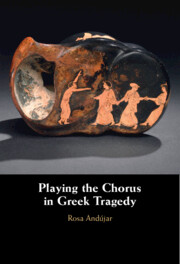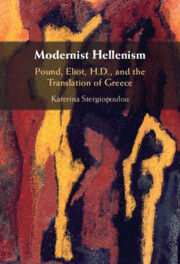Refine search
Actions for selected content:
58 results
Coda
-
- Book:
- Playing the Chorus in Greek Tragedy
- Published online:
- 23 October 2025
- Print publication:
- 06 November 2025, pp 281-283
-
- Chapter
- Export citation
Chapter 4 - Interacting with the Chorus
-
- Book:
- Playing the Chorus in Greek Tragedy
- Published online:
- 23 October 2025
- Print publication:
- 06 November 2025, pp 215-280
-
- Chapter
- Export citation
Chapter 3 - Interrupting the Chorus
-
- Book:
- Playing the Chorus in Greek Tragedy
- Published online:
- 23 October 2025
- Print publication:
- 06 November 2025, pp 154-214
-
- Chapter
- Export citation
Introduction
-
- Book:
- Playing the Chorus in Greek Tragedy
- Published online:
- 23 October 2025
- Print publication:
- 06 November 2025, pp 1-25
-
- Chapter
- Export citation

Playing the Chorus in Greek Tragedy
-
- Published online:
- 23 October 2025
- Print publication:
- 06 November 2025
RETHINKING CLEMENT’S EURIPIDES: SOURCE AND SPECTACLE
-
- Journal:
- The Classical Quarterly , First View
- Published online by Cambridge University Press:
- 04 June 2025, pp. 1-17
-
- Article
-
- You have access
- Open access
- HTML
- Export citation

The Performance Reception of Greek Tragedy in Ancient Theatres
-
- Published online:
- 20 March 2025
- Print publication:
- 03 April 2025
AJAX’S ‘GREAT TIME’ AND STOBAEUS’ TRAGIC QUOTATIONS: SOPHOCLES, AJAX 714
-
- Journal:
- The Classical Quarterly / Volume 74 / Issue 2 / December 2024
- Published online by Cambridge University Press:
- 25 March 2025, pp. 446-451
- Print publication:
- December 2024
-
- Article
-
- You have access
- Open access
- HTML
- Export citation
Chapter 2 - “The glory that was this and the grandeur that was the other”
- from Part I - Hellenists and Modernists
-
- Book:
- Modernist Hellenism
- Published online:
- 21 November 2024
- Print publication:
- 28 November 2024, pp 81-132
-
- Chapter
- Export citation

Modernist Hellenism
- Pound, Eliot, H.D., and the Translation of Greece
-
- Published online:
- 21 November 2024
- Print publication:
- 28 November 2024
1 - Introduction
-
- Book:
- Helping Friends and Harming Enemies
- Published online:
- 06 June 2024
- Print publication:
- 13 June 2024, pp 1-25
-
- Chapter
- Export citation
3 - Comic inversion and inverted commas: Aristophanes and parody
-
- Book:
- The Poet's Voice
- Published online:
- 31 October 2024
- Print publication:
- 13 June 2024, pp 167-222
-
- Chapter
- Export citation
2 - Helping friends and harming enemies
-
- Book:
- Helping Friends and Harming Enemies
- Published online:
- 06 June 2024
- Print publication:
- 13 June 2024, pp 26-59
-
- Chapter
- Export citation
DID EURIPIDES’ ANDROMACHE PREMIERE OUTSIDE ATHENS?
-
- Journal:
- The Classical Quarterly / Volume 73 / Issue 2 / December 2023
- Published online by Cambridge University Press:
- 01 March 2024, pp. 558-564
- Print publication:
- December 2023
-
- Article
-
- You have access
- Open access
- HTML
- Export citation
7 - Playing with Shadows in Heidegger’s Reading of Greek Tragedy
- from II - Heidegger and Greek Literature
-
-
- Book:
- Heidegger and Literary Studies
- Published online:
- 09 November 2023
- Print publication:
- 23 November 2023, pp 150-182
-
- Chapter
- Export citation
3 - Phoenician Women
-
- Book:
- Monody in Euripides
- Published online:
- 27 July 2023
- Print publication:
- 10 August 2023, pp 112-156
-
- Chapter
- Export citation
2 - Iphigenia among the Taurians
-
- Book:
- Monody in Euripides
- Published online:
- 27 July 2023
- Print publication:
- 10 August 2023, pp 82-111
-
- Chapter
- Export citation
Conclusion
-
- Book:
- Monody in Euripides
- Published online:
- 27 July 2023
- Print publication:
- 10 August 2023, pp 187-189
-
- Chapter
- Export citation
1 - Ion
-
- Book:
- Monody in Euripides
- Published online:
- 27 July 2023
- Print publication:
- 10 August 2023, pp 41-81
-
- Chapter
- Export citation
Introduction
-
- Book:
- Monody in Euripides
- Published online:
- 27 July 2023
- Print publication:
- 10 August 2023, pp 1-40
-
- Chapter
- Export citation
